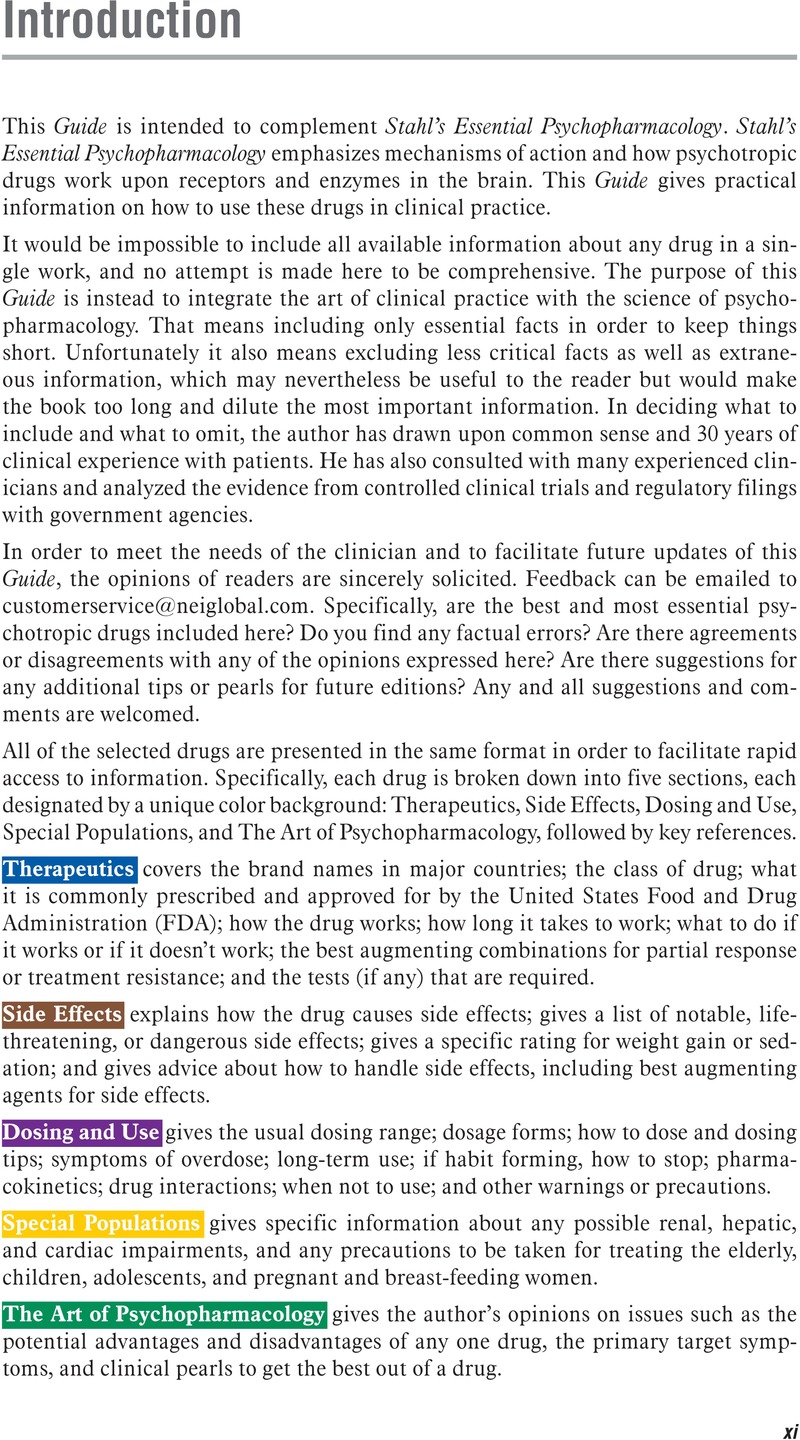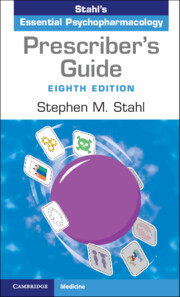Book contents
- Stahl’s Essential Psychopharmacology
- Stahl’s Essential Psychopharmacology
- Copyright page
- Contents
- Introduction
- List of icons
- ACAMPROSATE
- AGOMELATINE
- ALPRAZOLAM
- AMISULPRIDE
- AMITRIPTYLINE
- AMOXAPINE
- AMPHETAMINE (D)
- AMPHETAMINE (D,L)
- ARIPIPRAZOLE
- ARMODAFINIL
- ASENAPINE
- ATOMOXETINE
- BENZTROPINE
- BLONANSERIN
- BREMELANOTIDE
- BREXANOLONE
- BREXPIPRAZOLE
- BUPRENORPHINE
- BUPROPION
- BUSPIRONE
- CAPRYLIDENE
- CARBAMAZEPINE
- CARIPRAZINE
- CHLORDIAZEPOXIDE
- CHLORPROMAZINE
- CITALOPRAM
- CLOMIPRAMINE
- CLONAZEPAM
- CLONIDINE
- CLORAZEPATE
- CLOZAPINE
- CYAMEMAZINE
- DARIDOREXANT
- DESIPRAMINE
- DESVENLAFAXINE
- DEUTETRABENAZINE
- DEXMEDETOMIDINE
- DEXTROMETHORPHAN–BUPROPION
- DEXTROMETHORPHAN–QUINIDINE
- DIAZEPAM
- DIPHENHYDRAMINE
- DISULFIRAM
- DONEPEZIL
- DOTHIEPIN
- DOXEPIN
- DULOXETINE
- ESCITALOPRAM
- ESKETAMINE
- ESTAZOLAM
- ESZOPICLONE
- FLIBANSERIN
- FLUMAZENIL
- FLUNITRAZEPAM
- FLUOXETINE
- FLUPENTHIXOL
- FLUPHENAZINE
- FLURAZEPAM
- FLUVOXAMINE
- GABAPENTIN
- GALANTAMINE
- GUANFACINE
- HALOPERIDOL
- HYDROXYZINE
- ILOPERIDONE
- IMIPRAMINE
- ISOCARBOXAZID
- KETAMINE
- LAMOTRIGINE
- LEMBOREXANT
- LEVETIRACETAM
- LEVOMILNACIPRAN
- LISDEXAMFETAMINE
- LITHIUM
- LOFEPRAMINE
- LOFEXIDINE
- LOFLAZEPATE
- LORAZEPAM
- LOXAPINE
- LUMATEPERONE
- LURASIDONE
- MAPROTILINE
- MEMANTINE
- METHYLFOLATE (L)
- METHYLPHENIDATE (D)
- METHYLPHENIDATE (D,L)
- MIANSERIN
- MIDAZOLAM
- MILNACIPRAN
- MIRTAZAPINE
- MOCLOBEMIDE
- MODAFINIL
- MOLINDONE
- NALMEFENE
- NALTREXONE
- NALTREXONE–BUPROPION
- NEFAZODONE
- NORTRIPTYLINE
- OLANZAPINE
- OLANZAPINE–SAMIDORPHAN
- OXAZEPAM
- OXCARBAZEPINE
- PALIPERIDONE
- PAROXETINE
- PEROSPIRONE
- PERPHENAZINE
- PHENELZINE
- PHENTERMINE–TOPIRAMATE
- PIMAVANSERIN
- PIMOZIDE
- PIPOTHIAZINE
- PITOLISANT
- PRAZOSIN
- PREGABALIN
- PROPRANOLOL
- PROTRIPTYLINE
- QUAZEPAM
- QUETIAPINE
- RAMELTEON
- REBOXETINE
- RISPERIDONE
- RIVASTIGMINE
- SELEGILINE
- SERDEXMETHYLPHENIDATE
- SERTINDOLE
- SERTRALINE
- SILDENAFIL
- SODIUM OXYBATE
- SOLRIAMFETOL
- SULPIRIDE
- SUVOREXANT
- TASIMELTEON
- TEMAZEPAM
- THIORIDAZINE
- THIOTHIXENE
- TIAGABINE
- TIANEPTINE
- TOPIRAMATE
- TRANYLCYPROMINE
- TRAZODONE
- TRIAZOLAM
- TRIFLUOPERAZINE
- TRIHEXYPHENIDYL
- TRIIODOTHYRONINE
- TRIMIPRAMINE
- VALBENAZINE
- VALPROATE
- VARENICLINE
- VENLAFAXINE
- VILAZODONE
- VILOXAZINE
- VORTIOXETINE
- ZALEPLON
- ZIPRASIDONE
- ZOLPIDEM
- ZONISAMIDE
- ZOPICLONE
- ZOTEPINE
- ZUCLOPENTHIXOL
- Index by Drug Name
- Index by Drug Use
- Index by Drug Class
- Abbreviations
Introduction
Published online by Cambridge University Press: 03 April 2024
- Stahl’s Essential Psychopharmacology
- Stahl’s Essential Psychopharmacology
- Copyright page
- Contents
- Introduction
- List of icons
- ACAMPROSATE
- AGOMELATINE
- ALPRAZOLAM
- AMISULPRIDE
- AMITRIPTYLINE
- AMOXAPINE
- AMPHETAMINE (D)
- AMPHETAMINE (D,L)
- ARIPIPRAZOLE
- ARMODAFINIL
- ASENAPINE
- ATOMOXETINE
- BENZTROPINE
- BLONANSERIN
- BREMELANOTIDE
- BREXANOLONE
- BREXPIPRAZOLE
- BUPRENORPHINE
- BUPROPION
- BUSPIRONE
- CAPRYLIDENE
- CARBAMAZEPINE
- CARIPRAZINE
- CHLORDIAZEPOXIDE
- CHLORPROMAZINE
- CITALOPRAM
- CLOMIPRAMINE
- CLONAZEPAM
- CLONIDINE
- CLORAZEPATE
- CLOZAPINE
- CYAMEMAZINE
- DARIDOREXANT
- DESIPRAMINE
- DESVENLAFAXINE
- DEUTETRABENAZINE
- DEXMEDETOMIDINE
- DEXTROMETHORPHAN–BUPROPION
- DEXTROMETHORPHAN–QUINIDINE
- DIAZEPAM
- DIPHENHYDRAMINE
- DISULFIRAM
- DONEPEZIL
- DOTHIEPIN
- DOXEPIN
- DULOXETINE
- ESCITALOPRAM
- ESKETAMINE
- ESTAZOLAM
- ESZOPICLONE
- FLIBANSERIN
- FLUMAZENIL
- FLUNITRAZEPAM
- FLUOXETINE
- FLUPENTHIXOL
- FLUPHENAZINE
- FLURAZEPAM
- FLUVOXAMINE
- GABAPENTIN
- GALANTAMINE
- GUANFACINE
- HALOPERIDOL
- HYDROXYZINE
- ILOPERIDONE
- IMIPRAMINE
- ISOCARBOXAZID
- KETAMINE
- LAMOTRIGINE
- LEMBOREXANT
- LEVETIRACETAM
- LEVOMILNACIPRAN
- LISDEXAMFETAMINE
- LITHIUM
- LOFEPRAMINE
- LOFEXIDINE
- LOFLAZEPATE
- LORAZEPAM
- LOXAPINE
- LUMATEPERONE
- LURASIDONE
- MAPROTILINE
- MEMANTINE
- METHYLFOLATE (L)
- METHYLPHENIDATE (D)
- METHYLPHENIDATE (D,L)
- MIANSERIN
- MIDAZOLAM
- MILNACIPRAN
- MIRTAZAPINE
- MOCLOBEMIDE
- MODAFINIL
- MOLINDONE
- NALMEFENE
- NALTREXONE
- NALTREXONE–BUPROPION
- NEFAZODONE
- NORTRIPTYLINE
- OLANZAPINE
- OLANZAPINE–SAMIDORPHAN
- OXAZEPAM
- OXCARBAZEPINE
- PALIPERIDONE
- PAROXETINE
- PEROSPIRONE
- PERPHENAZINE
- PHENELZINE
- PHENTERMINE–TOPIRAMATE
- PIMAVANSERIN
- PIMOZIDE
- PIPOTHIAZINE
- PITOLISANT
- PRAZOSIN
- PREGABALIN
- PROPRANOLOL
- PROTRIPTYLINE
- QUAZEPAM
- QUETIAPINE
- RAMELTEON
- REBOXETINE
- RISPERIDONE
- RIVASTIGMINE
- SELEGILINE
- SERDEXMETHYLPHENIDATE
- SERTINDOLE
- SERTRALINE
- SILDENAFIL
- SODIUM OXYBATE
- SOLRIAMFETOL
- SULPIRIDE
- SUVOREXANT
- TASIMELTEON
- TEMAZEPAM
- THIORIDAZINE
- THIOTHIXENE
- TIAGABINE
- TIANEPTINE
- TOPIRAMATE
- TRANYLCYPROMINE
- TRAZODONE
- TRIAZOLAM
- TRIFLUOPERAZINE
- TRIHEXYPHENIDYL
- TRIIODOTHYRONINE
- TRIMIPRAMINE
- VALBENAZINE
- VALPROATE
- VARENICLINE
- VENLAFAXINE
- VILAZODONE
- VILOXAZINE
- VORTIOXETINE
- ZALEPLON
- ZIPRASIDONE
- ZOLPIDEM
- ZONISAMIDE
- ZOPICLONE
- ZOTEPINE
- ZUCLOPENTHIXOL
- Index by Drug Name
- Index by Drug Use
- Index by Drug Class
- Abbreviations
Summary

- Type
- Chapter
- Information
- Prescriber's GuideStahl's Essential Psychopharmacology, pp. xi - xivPublisher: Cambridge University PressPrint publication year: 2024

